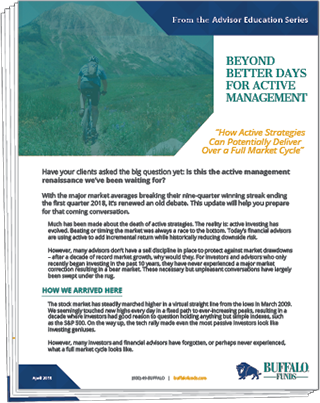Beyond Better Days for Active Management
“How Active Strategies Can Potentially Deliver Over a Full Market Cycle”
Is this the active management renaissance we’ve been waiting for?
With the major market averages breaking their nine-quarter winning streak ending the first quarter 2018, it’s renewed an old debate. This update will help you prepare for that coming conversation.
In this report, we cover:
|
|
Much has been made about the death of active strategies. The reality is: active investing has evolved. Beating or timing the market was always a race to the bottom. Many financial advisers today are using active strategies, seeking to add incremental return while reducing downside risk. Download the report to find out more.
Opinions expressed are those of the author or Funds and are subject to change, are not intended to be a forecast of future events, a guarantee of future results, nor investment advice.
Active investing has higher management fees because of the manager’s increased level of involvement while passive investing has lower management and operating fees. Investing in both actively and passively managed mutual funds involves risk and principal loss is possible. Both actively and passively managed mutual funds generally have daily liquidity. There are no guarantees regarding the performance of actively and passively managed mutual funds. Actively managed mutual funds may have higher portfolio turnover than passively managed funds. Excessive turnover can limit returns and can incur capital gains. Stocks, hedge funds, mutual funds, ETF’s and other investments products have different risk-return profiles, which should be considered when investing. All investments contain risk and may lose value.
Fundamental Approach
We get to know the companies we invest in and learn how they run their business.
Top-Down & Bottom-Up
We identify Top-Down broad, secular growth trends and search for companies from the Bottom-Up.
Proprietary Philosophy
We construct our portfolios based on our own proprietary investment strategy.
Disciplined Investing
Sticking to our disciplined investment strategy ensures we maintain a consistent, balanced approach.

